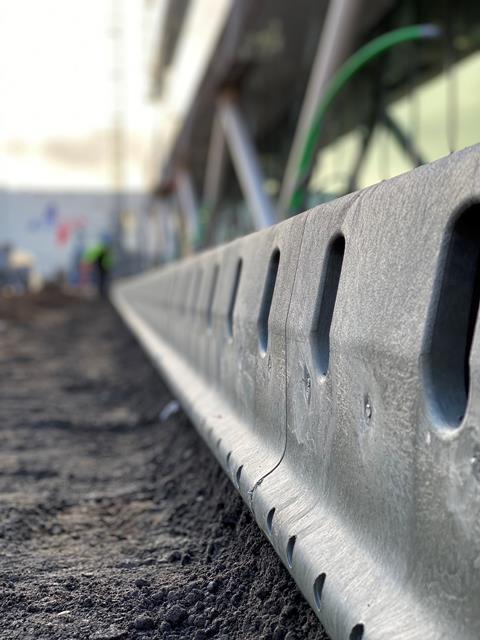What types of problems occur in a drain and what are some of the solutions available? Building Design spoke to Steve Bennett to find out

What is the first port of call when designing a drainage system?
The primary function of any surface drainage system is to collect, compound and evacuate surface water. Water will collect on any surface/structure that is open to the elements, so this is critical to prevent flooding and protect surfaces. The safety of users is also a key consideration.
An optimum surface drainage system would collect and compound run-off within a shallow construction depth, accessible for maintenance and draining to the minimum number of outlet points.
For best silt transit and reduced maintenance, surface drainage systems should be designed to function at, or close to a required maximum designed capacity.
Collection will naturally occur at low points across a site and therefore levels will generally dictate the positions for collection. However, where possible it is good practice to position collection at the lowest area of risk and chose an appropriate method considering the risk.
Traditional point-drainage relies on the surfacing to drive the rainfall to multiple gully outlets, which often requires a criss-cross of levels to each point of outlet.
Linear surface drainage systems provide the most efficient collection as they can simplify surface levels, which can improve the efficiency of collection and operations once constructed.
Combined kerb and drainage solutions also work well as they are often positioned at the boundary of a site/structure away from building or operating areas and perform a dual function of kerbing and drainage with just one installation cost.
For large multi-use projects with areas of varied operation and size, an optimum surface drainage solution is a combination of all three methods subject to levels onsite and site conditions.
At each outlet point, the compounded run-off is then taken into a separate system of underground carrier pipes, storm connections, balancing ponds or attenuation systems.
The volume held on site and the rate of allowable discharge to existing adopted systems downstream are subject to local restrictions and an overall project drainage strategy. Surface water collection, attenuation and discharge should all work together within the scope of the strategy.

What types of problems can occur in a drain?
In terms of the hydraulic function, surface drainage systems are designed to drain empty, delivering run-off continually during a storm to outlets. The maximum capacity of a system can be determined by the maximum rate of rainfall in real-time during peak storm intensity.
If oversized, they can silt over time and therefore become less effective when the maximum designed capacity is needed during a peak storm event.
At outlets, the run-off is taken into the underground system which, in many cases, is subject to release restrictions.
As a result, the capacity is determined more by the collected volume across a designed peak storm event/period.
Systems should be designed to work within the designed capacity in terms of the maximum rate of rainfall over a storm period (primary - surface drainage) and maximum volume dropped (secondary - evacuation from outlets/storage on site). It’s a question of balance.
Most systems work with gravity only. Providing both systems are working together with a designed capacity to cope with volume and rate of drop, only infrequent inspection would be needed, picking up any compounding issue that can then be assessed and cleared where necessary.
What are some of the best solutions to improving your drainage design?
For an optimum system, it is about getting everything right. Sizing correctly in terms of both collection and storage is important, as well as choosing the position with the lowest risk. Choosing the appropriate method and specifying a system and product that can vary across a site with multiple uses are both also important considerations.
You must also ensure the system is fully integrated so it works within the structure without issue.
Manufacturers’ guidance will often recommend “minimum” strengths of material or minimum dimensions of bed/haunch, which in most cases prove to be the maximum. Upping the strength and or size of bed or adding additional reinforcement beyond the minimum will almost always extend the life of the system and the integration.
Another tip would be to make the system as simple as it can be.

What types of drainage systems should design teams be specifying?
For collection systems, linear drainage systems generally offer the most cost-effective solutions but very often it is a combination of linear and point drainage as most buildings and infrastructure will have different areas of operation/risk.
Managing collected run-off is key so systems that hold flows on site or naturally release to prevent pluvial flooding and pollution and encourage water conservation are best.
Urban infrastructure design has changed towards more environmentally friendly modes of transport, prioritising accessibility for wheelchair users, pedestrians and cyclists, which often requires an innovative solution to drainage.
What are some of the common mistakes made during the drainage installation process?
With surface drainage systems it is vital that the system is fully integrated into the structure so it can perform the drainage function and deal with the conditions and loads resulting from the day-to-day operations of the structure.
The minimum strength of a product is determined by standards, but a well-integrated installation can enhance the load performance further in use. A higher-strength product with a weak installation or integration will generally perform much worse than a lower-strength product in a sound one.
Once the integration is compromised, the primary inflow is affected and this often causes other issues from standing water such as surface corrosion, hydrostatic loads and flooding.
Designers and installers should assess risk fully, taking into account both the product and the installation detail. This determines the correct product choice and the correct method of installation.
With climate change resulting in more adverse weather, are there any extra precautions that should be taken?
With the ever-changing weather events resulting from climate change surely designers should now be quantifying an environmental value to the products and systems they chose, especially when it comes to drainage systems, which are themselves a measure to contain and control the results from weather events.
All drainage systems are designed for likely predicted storm events taken over a specific period. Designers in the past would generally design systems to cope with worst-case likely storm events over a one-year or five-year cycle.
With ever-increasing storm events, it is usual for designers now to increase criteria to allow for 10 or 20-year storm periods after which the data is less reliable.
A further/alternative measure is to design to a specific storm period and then add 20% to 30%, or more dependent on risk, to allow for climate change.
Postscript
Steve Bennett is the managing director at Dura Products













No comments yet